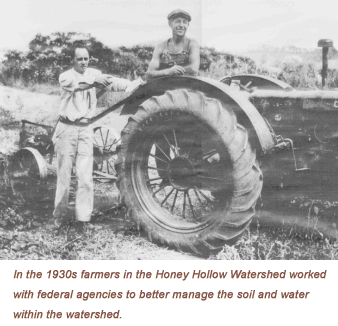 Among Solebury Township’s four National Historic Landmarks, the Honey Hollow Watershed is unique because it is the only agricultural National Landmark in the nation.
Among Solebury Township’s four National Historic Landmarks, the Honey Hollow Watershed is unique because it is the only agricultural National Landmark in the nation.
The Honey Hollow Watershed is comprised of five farms of 650-acres along Route 263 and Creamery Road. It is the first small upland watershed with multiple private owners in agricultural use to demonstrate that cooperative local action, supported by Federal technical assistance, is a practical method of achieving national goals in flood prevention and soil, water, and wildlife conservation. As such, it has served as a prototype for conservation of thousands of similar small watersheds throughout the nation.
The history of the watershed in regard to conservation began in the 1930s, when the owners of the farms along Honey Hollow Creek observed how their fields were washing away. The change from cultivation done by horse drawn equipment to tractors and large machinery had caused serious sheet and gully erosion on the upland farms, while siltation struck those on the downslope. It was obvious that the erosion must be checked, and that no individual landowner could correct the situation. A combined effort was required or the land would be ruined for agricultural use. The five owners of the farmland in the Honey Hollow watershed took their tale to the regional office of the newly formed Soil Conservation Service. The Regional Director, Dr. J. P. Jones, agreed to provide technical assistance, and the landowners agreed to work together to carry out the soil and water conservation practices prescribed for each tract. Within the next two years terraces and diversion ditches had been constructed to control runoff on steep slopes, long dense hedges had been planted to check erosion and provide water life habitat, and several ponds were built and stocked with fish.
Almost overnight the “Honey Hollow Project” attracted attention from high levels in the Department of Agriculture as well as farmers across the country seeking ways to improve their land. Vice President Henry Wallace visited in 1944 and came back other times. Louis Bromfield, novelist and conservationist, was also a good friend of the project. The Watershed still retains all the conservation measures adopted in the late 1930s, terraces, contour-plowed fields, diversion ditches, wildlife hedges, ponds, and tree lands.
Beginning in the 1940s many government agencies and farmers visited the watershed to learn about the conservation management techniques. It seemed only natural that part of the watershed should be devoted to conservation education, and so, through the efforts of several of the farm owners, the Honey Hollow Environmental Education Center was born and continues to educate the public to this day.
Recognizing the significance of this watershed project, in 1969 the National Park Service gave the Honey Hollow Watershed its highest honor, naming it a National Historic Landmark.
While the Landmark status was awarded for agricultural conservation, most of the 18th century houses and barns on those 5 farms still survive today. Built of fieldstone in the Pennsylvania tradition, all of the sturdy structures are simple in design and construction.
The five families who banded together to form the Honey Hollow Watershed were chosen as Honored Citizens by the Society in 2003.
View an interactive map of the locations of nationally recognized properties and districts in Solebury Township.
For more information, read The Story of Honey Hollow and the Origins of the Conservation Movement in Pennsylvania by P. Alston Waring, one of the farm owners, or visit the National Park Service site.
